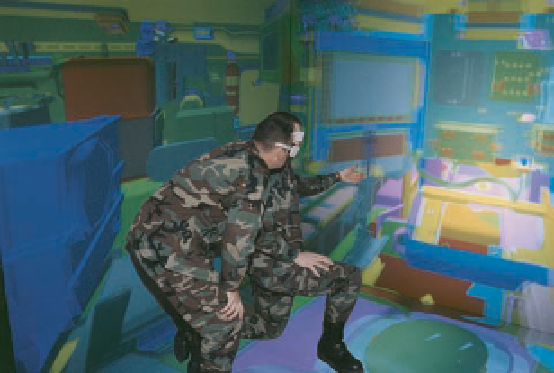Information Technology Reference
In-Depth Information
The PowerWall is a virtual reality
system that displays large models in
accurate dimensions.
(Source: Courtesy of Fakespace
Systems, Inc.)
The Electronic Visualization Laboratory at the University of Illinois at Chicago intro-
duced a room constructed of large screens on three walls and the floor on which the graphics
are projected. The CAVE, as this room is called, provides the illusion of immersion by pro-
jecting stereo images on the walls and floor of a room-sized cube (
http://cave.ncsa.uiuc.edu
).
Several persons wearing lightweight stereo glasses can enter and walk freely inside the CAVE.
A head-tracking system continuously adjusts the stereo projection to the current position of
the leading viewer.
Military personnel train in an
immersive CAVE system.
(Source: Courtesy of Fakespace
Systems, Inc.)
Users hear sounds in the virtual world through earphones. The information reported by
the position tracker is also used to update audio signals. When a sound source in virtual space
is not directly in front of or behind the user, the computer transmits sounds to arrive at one
ear a little earlier or later than at the other and to be a little louder or softer and slightly
different in pitch.
The
haptic
interface, which relays the sense of touch and other physical sensations in the
with the use of a glove and position tracker, the computer locates the user's hand and measures
finger movements. The user can reach into the virtual world and handle objects; however, it
is difficult to generate the sensations of a person tapping a hard surface, picking up an object,





